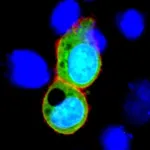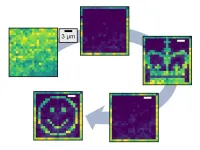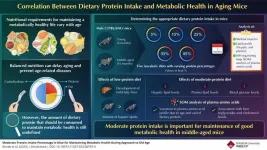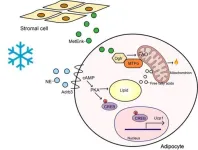(Press-News.org) Electron microscopes give us insight into the tiniest details of materials and can visualize, for example, the structure of solids, molecules or nanoparticles with atomic resolution. However, most materials in nature are not static. They constantly interact, move and reshape between initial and final configurations. One of the most general phenomena is the interaction between light and matter, which is omnipresent in materials such as solar cells, displays or lasers. These interactions are defined by electrons pushed and pulled around by the oscillations of light, and the dynamics are extremely fast: light waves oscillate at attoseconds, the billionth of a billionth of a second.
Until now, it has been very difficult to directly visualize these extremely fast processes in space and time, but that is exactly what a team of physicists from the University of Konstanz has now succeeded in. They recorded movies with attosecond time resolution in a transmission electron microscope, providing new insights into the functionality of nanomaterials and dielectric meta-atoms. They recently published their results in the scientific journal Nature.
Generation of ultrashort electron pulses
"If you look closely, almost all phenomena in optics, nanophotonics or metamaterials occur on time scales below one oscillation period of a light wave," explains Peter Baum, physics professor and head of the Light and Matter Group at the University of Konstanz. "To film the ultrafast interactions between light and matter, we therefore need a time resolution of attoseconds." To achieve such an extreme recording speed, Baum's research group uses the fast oscillations of a continuous-wave laser to convert the electron beam of an electron microscope into a sequence of ultrashort electron pulses.
In this process, a thin silicon membrane creates a periodic acceleration and deceleration of the electrons. "This modulation causes the electrons to catch up with each other. After some time, they convert into a train of ultrashort pulses," explains David Nabben, doctoral student and first author of the study. Another laser wave creates the interaction with the sample object. The ultrashort electron pulses are then used to measure the object’s response to the laser light, frozen in time like in a stroboscope. In the end, the researchers obtain a movie of the processes with attosecond time resolution.
Investigation of nanophotonic phenomena
In their study, the scientists present several examples of time-resolved measurements in nanomaterials. The experiments show, for example, the emergence of chiral surface waves that can be controlled by the researchers to travel in a specific spatial direction, or characteristic time delays between different modes of radiation from nanoantennas. What is more, the scientists not only investigate such surface phenomena, but also film the electromagnetic processes inside a waveguide material.
The results are highly interesting for further developments in nanophotonics, but also demonstrate the very broad application range of the new attosecond electron microscopy. "The direct measurement of the electromagnetic functionality of materials as a function of space and time is not only of great value for fundamental science, but also opens up the way for new developments in photonic integrated circuits or metamaterials," Nabben summarizes the impact of the results.
Key facts:
EMBARGOED UNTIL WEDNESDAY, 31 MAY 2023, 17:00 CEST (16:00 LONDON TIME, 11:00 U.S. EASTERN TIME)
Original publication: D. Nabben, J. Kuttruff, L. Stolz, A. Ryabov, P. Baum (2023) Attosecond electron microscopy of sub-cycle optical dynamics. Nature; DOI: 10.1038/s41586-023-06074-9
Researchers from Konstanz build an attosecond electron microscope.
It produces movies of light-matter interactions with attosecond time resolution, faster than the oscillations of light.
The method allows insights into the atomic origins of light-matter interactions and is a major advance for nanophotonics.
Funding: German Research Foundation (DFG; SFB 1432), Vector Stiftung and Dr. K. H. Eberle Stiftung
Note to editors:
You can download images here:
https://www.uni-konstanz.de/fileadmin/pi/fileserver/2023/das_schnellste_elektronenmikroskop_01.jpg
https://www.uni-konstanz.de/fileadmin/pi/fileserver/2023/das_schnellste_elektronenmikroskop_02.jpg
Caption (both images): Experimental setup of the attosecond electron microscope.
Images: Dr. Gillian Kiliani, University of Konstanz
END
The world's fastest electron microscope
Researchers at the University of Konstanz have succeeded for the first time in filming the interactions of light and matter in an electron microscope with attosecond time resolution
2023-05-31
ELSE PRESS RELEASES FROM THIS DATE:
Can we learn to think further ahead?
2023-05-31
Chess grandmasters are often held up as the epitome of thinking far ahead. But can others, with a modest amount of practice, learn to think further ahead?
In addressing this question, a team of cognitive scientists has created a computational model that reveals our ability to plan for future events. The work enhances our understanding of the factors that affect decision-making and shows how we can boost our planning skills through practice.
The research, conducted by scientists in New York University’s Center for Neural Science and ...
Further link identified between autoimmunity and schizophrenia
2023-05-31
Researchers from Tokyo Medical and Dental University (TMDU) identify a protein in some people with schizophrenia that causes schizophrenia-like features in mice
Tokyo, Japan – Links have been reported between schizophrenia and proteins produced by the immune system that can act against one’s own body, known as autoantibodies. In a study published last month in Brain Behavior and Immunity, Japanese researchers identified autoantibodies that target a ‘synaptic adhesion protein’, neurexin 1α, in a subset of patients with schizophrenia. When injected into mice, the ...
New study unveils nanocrystal shines on and off indefinitely
2023-05-31
A research team affiliated with UNIST has made a significant breakthrough in uncovering the potential of ultra-photostable avalanching nanoparticles (ANP). Their study demonstrates that such particles can perform unlimited photoswitching, leading to new advancements in fields like optical probes, 3D optical memory, and super-resolution microscopy.
This breakthrough has been achieved through the efforts of Professor Yung Doug Suh and his research team in the Department of Chemistry at Ulsan National Institute of Science and Technology (UNIST), in collaboration with researchers from Columbia University and ...
A nanocrystal shines on and off indefinitely
2023-05-31
New York, NY—May 31, 2023—In 2021, lanthanide-doped nanoparticles made waves—or rather, an avalanche—when Changwan Lee, then a PhD student in Jim Schuck’s lab at Columbia Engineering, set off an extreme light-producing chain reaction from ultrasmall crystals developed at the Molecular Foundry at Berkeley Lab. Those same crystals are back again with a blink that can now be deliberately and indefinitely controlled.
“We’ve found the first fully photostable, fully photoswitchable nanoparticle—a holy grail of nanoprobe design,” said Schuck, associate ...
Eat right, live longer: could a moderate protein diet be the coveted elixir of youth?
2023-05-31
As the proverb “You are what you eat” goes, the type of food we consume influences our health and longevity all through our lives. In fact, there is a direct association between age-related nutritional requirements and metabolic health. Optimal nutrition according to age can help maintain metabolic health, thereby improving the health span (period of life without diseases) and lifespan of an individual. Different nutritional interventions involving varied calorie and protein intake have been known to improve the health and lifespan of rodents and primates. Furthermore, recent studies have also reported the association of dietary macronutrients (proteins, ...
How Canadians' lifestyle behaviours changed during the COVID-19 pandemic
2023-05-31
Sixty per cent of roughly 1,600 Canadians who took part in a new McGill University study say their lifestyle habits either stayed the same or improved during the COVID-19 pandemic. On the flip side, 40% of participants say they adopted less healthy lifestyle habits, including worsened eating habits, sleep quality, decreased physical activity and weight gain. The research is based on the Canadian COVIDiet study of Canadians between the ages of 18 to 89 years old. Researchers from McGill’s School of Human Nutrition collected data from across the country during the first wave of infections. ...
Researchers improved the catastrophic failure assessment of sealed cabin for ultra large manned spacecraft in M/OD environment
2023-05-31
Hypervelocity impacts of Micrometeoroid and Orbital Debris (M/OD) seriously threaten the safety of manned spacecraft and astronauts in orbit. At present, M/OD above 10 cm, which can be monitored and predicted in advance, can usually be avoided by orbital maneuver. As for the small-size M/OD, because of the difficulty of monitoring, it is the main impact threat, as well as the main object of impact risk assessment and protection design of manned spacecraft. The probability of no penetration (PNP) of the sealed cabin under M/OD impact is usually used as ...
SwRI’s Thomas Briggs receives SAE International’s Forest R. McFarland Award
2023-05-31
SAN ANTONIO — May 31, 2023 —Dr. Thomas E. Briggs, an Institute engineer in Southwest Research Institute’s Powertrain Engineering Division, has received the Forest R. McFarland Award by SAE International, an organization that works to advance mobility, knowledge and solutions for humanity’s benefit.
Established in 1979, the award serves to honor the late Forest R. McFarland, a long-time SAE International member, for his many contributions to the organization. The award recognizes outstanding contributions by volunteers who further the goals of SAE ...
A new player unveiled for lipid oxidation
2023-05-31
Overweight and obesity pose significant health risks, including an increased likelihood of developing diabetes, cardiovascular disease, and cancer. Researchers are seeking practical ways to promote the oxidation of lipids, which could help balance energy storage and consumption. A recent study has identified opioid growth factor receptor (Ogfr) gene as a promising new target for this process.
Rodents possess thermogenic fat that includes brown and beige adipocytes, which have a high capacity to uptake and utilize glucose ...
More than 80% of people who inject drugs test positive for fentanyl—but only 18% intend to take it
2023-05-31
More than 80% of New Yorkers who inject drugs test positive for the opioid fentanyl, despite only 18% reporting using it intentionally, according to a new study by researchers at the NYU School of Global Public Health.
The findings, published in the International Journal of Drug Policy, suggest that many people who inject drugs are unknowingly using fentanyl, which may increase their risk for overdose and potentially their tolerance to fentanyl if it is used over time.
In 2021, more than 100,000 people died of a drug overdose in the United States, with 66% of these deaths involving illicit fentanyl—a synthetic opioid that is 50 to 100 times more potent than morphine.
In ...
LAST 30 PRESS RELEASES:
Making lighter work of calculating fluid and heat flow
Normalizing blood sugar can halve heart attack risk
Lowering blood sugar cuts heart attack risk in people with prediabetes
Study links genetic variants to risk of blinding eye disease in premature infants
Non-opioid ‘pain sponge’ therapy halts cartilage degeneration and relieves chronic pain
AI can pick up cultural values by mimicking how kids learn
China’s ecological redlines offer fast track to 30 x 30 global conservation goal
Invisible indoor threats: emerging household contaminants and their growing risks to human health
Adding antibody treatment to chemo boosts outcomes for children with rare cancer
Germline pathogenic variants among women without a history of breast cancer
Tanning beds triple melanoma risk, potentially causing broad DNA damage
Unique bond identified as key to viral infection speed
Indoor tanning makes youthful skin much older on a genetic level
Mouse model sheds new light on the causes and potential solutions to human GI problems linked to muscular dystrophy
The Journal of Nuclear Medicine ahead-of-print tip sheet: December 12, 2025
Smarter tools for peering into the microscopic world
Applications open for funding to conduct research in the Kinsey Institute archives
Global measure underestimates the severity of food insecurity
Child survivors of critical illness are missing out on timely follow up care
Risk-based vs annual breast cancer screening / the WISDOM randomized clinical trial
University of Toronto launches Electric Vehicle Innovation Ontario to accelerate advanced EV technologies and build Canada’s innovation advantage
Early relapse predicts poor outcomes in aggressive blood cancer
American College of Lifestyle Medicine applauds two CMS models aligned with lifestyle medicine practice and reimbursement
Clinical trial finds cannabis use not a barrier to quitting nicotine vaping
Supplemental nutrition assistance program policies and food insecurity
Switching immune cells to “night mode” could limit damage after a heart attack, study suggests
URI-based Global RIghts Project report spotlights continued troubling trends in worldwide inhumane treatment
Neutrophils are less aggressive at night, explaining why nighttime heart attacks cause less damage than daytime events
Menopausal hormone therapy may not pose breast cancer risk for women with BRCA mutations
Mobile health tool may improve quality of life for adolescent and young adult breast cancer survivors
[Press-News.org] The world's fastest electron microscopeResearchers at the University of Konstanz have succeeded for the first time in filming the interactions of light and matter in an electron microscope with attosecond time resolution







